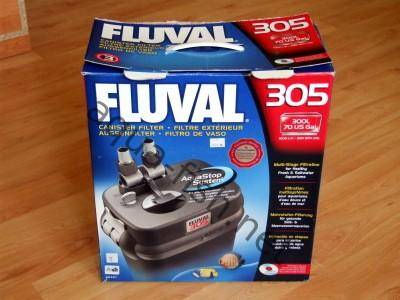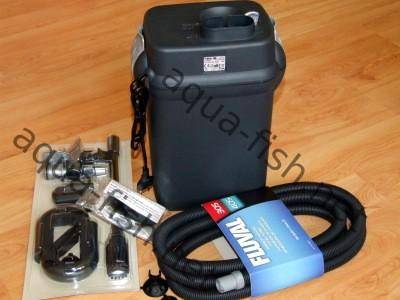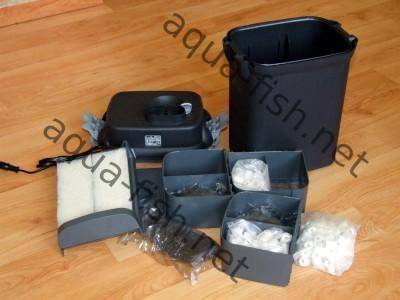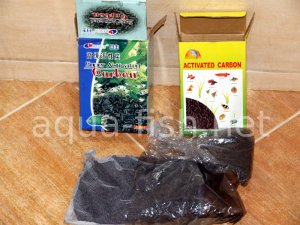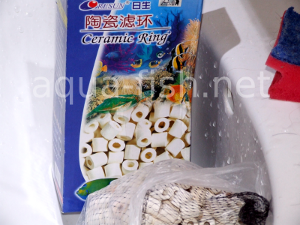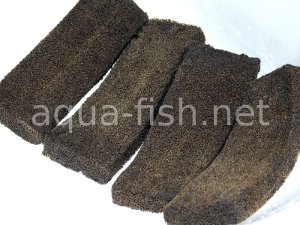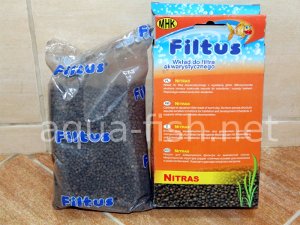Aquarium Filter Systems
Quick links - Answers
Brief Description
To a novice fish keeper, choosing which filtration system to purchase for their tank can sometimes be a bit confusing. There are several types to choose from so which will be the most efficient for their tank. There is no point paying out for a large canister filter when running a small tank, researching what is required can save money but still maintain high water quality.
The two main factors in choosing which system are, the volume of the tank, and what stock are you going to keep in it. In some cases a secondary filter may be required; if this is the case then it doesn’t always mean paying out for two identical ones, a smaller one will often be used for a back up. Planning your filtration system at the start will save a lot of time and hassle in the future.
So why do I need a filter?
An aquarium has closed parameters; this means that when your fish foul the water it is trapped in the tank unless pulled out by other means. In nature the seas, lakes or rivers will remove their pollutants, debris on their own, this cannot happen in an aquarium, we must supply the means to overcome this ourselves.
Fish waste will produce toxins in the water, the primary one being ammonia. With biological filtration, the ammonia is converted to nitrites, and then these are further converted to nitrates. The most common way of removing nitrates is by water changes; however they can also be reduced by introducing plants, even by the addition in saltwater tanks of a nitrate reactor.
Ammonia and nitrites are very harmful to the fish; this is why a tank must be cycled, to put it simply, your filter needs a large enough colony of beneficial bacteria to handle the waste. “New tank syndrome” occurs when livestock is added too quickly to the tank; this will result in some early deaths of your fish. Bacteria will not only colonize your filter but also the substrate and any décor you have in the tank.
The surface area of the filter media used for housing these bacteria is designed to hold as many as possible, with most filters this is usually done with sponges or ceramic rings. The bacteria also need oxygen for survival, either an air line can be added or some filters will draw in air so that the bacteria will always have contact with the dissolved oxygen.
Mechanical filtration is the second most important task your filter should provide. This is where any suspended debris and dirt is removed from the water prior to the biological filtration taking place. This is important as it can impede the bacteria from doing their job, so this action is usually the first area that the filter will concentrate on.
Chemical filtration, as the name implies, removes chemicals from the water. In most cases the chemicals are introduced by adding medication, but in other cases, they can be introduced when adding mains water while you are doing a water change. After running a course of medication, it is crucial that any left in the tank is removed as soon as possible.
Some of the basic filters do not allow for this, take this into consideration when deciding which one to purchase.
Types of filters
As mentioned above there are several types of filters to choose from, so I will now try to give you a quick guide as to what is available on the market, this should help make your decision much easier.
Under gravel filters:-
These filters have been around for years, in the early days of fish keeping they were the only one available for quite a while. There are mixed views on this type of filtration and many of the modern fish keepers will always avoid using them, but on the other side of the coin other keepers swear by them. They comprise of a filter plate that sits directly on the bottom of the aquarium, and then the gravel is placed on top. Uplift tubes, sited at the end of the plate, pull the water through the gravel, into the plate and out by the tubes.
Air pumps or power heads are used to create the flow.
These have to be installed before anything else, and if it blocks up at all, it can lead to the tank being stripped out to rectify the problem. As the gravel acts as the filter media, it means that a large surface area is being used for biological filtration, but no mechanical or chemical filtration is being performed. Debris will build up in the gravel, so vacuuming on a regular basis has to be performed. This will prevent the system from blocking up.
One of the disadvantages of these is that debris and mulch can build up underneath the plate, the only remedy for this is stripping out the tank to give it a good clean. After a period of time the water flow will also slow down. Some designs are equipped to allow for reverse flow facilities, this can cut down on the amount of maintenance required as the water is pushed back through the gravel.
Sponge filters:-
These are the most basic filter available to buy, yet they are extremely efficient in mechanical and biological filtration. A piece of sponge is slipped over an intake tube; the water flow is then created by adding an airline into the tube. Many of the modern sponge filters will have ribbed or convex shapes to increase the surface area, this of course will then increase the biological load that the filter can handle. These are used mainly in breeding tanks ( it prevents the fry from being sucked up into the intake tubes of other filters), and hospital tanks as there is no chemical filtration needed if medication is being added.
The only maintenance that is required for these is regular rinsing of the sponges in old tank water, as they tend to get clogged while they are performing the mechanical filtration. It is not advisable to use these in heavily stocked tanks unless they are there as a secondary filter.
Box filters:-
These are an old favorite of mine; I regard these as water polishers. They consist of a plastic box that is normally filled with filter wool and carbon. An air line supplies the water flow on the same principle as the under gravel and sponge filters. These are ideal for hospital tanks as they provide good mechanical and chemical filtration, this is ideal for removing medications that have been added. They cannot be used for biological filtration so a primary filter should be run alongside them.
Yet again the main disadvantage is that they will require cleaning on a regular basis, but this is a simple job to do.
External power filters:-
These are commonly known as hang on filters due to the fact that they simply hang on to the back of the tank. There are chambers inside them where a choice of mechanical and chemical filtration media can be added. The biological filtration is provided by a bio wheel, this is basically a sponge mounted on an axle. As this spins it pulls water out of the tank via an uplift tube, once the water has passed through all of the chambers it is returned to the tank by a plastic chute. The biggest drawback with these is the size of the media chambers; they can only carry enough media for tanks up to 50 gallons with normal stocking levels. For some reason, these have never been very popular in the U.K., but are widely used in the U.S and Canada.
Internal power filters:-
Internal filters are used underneath the water level, ideal for smaller tanks , but they would not cope with larger set ups.They are smaller than the external power filters, this in turn means that they do not have the room for a lot of filter media. Most of the models that I have used only contain two sponge sheets for mechanical and biological filtration.
They are usually attached to the inside of the tank with rubber suckers, this can be used as advantageous, it means they will still work when submerged on their sides. Ideal for low water levels as in turtle tanks. Some keepers are not too keen to see them being used as they can spoil the look of the inside of the tank.
External canister filters:-
Canister filters are ideal for the larger aquariums (over 30 gallons), normally they are set up in the aquarium cabinets directly underneath the tank. They provide all 3 stages of filtration and can hold many different types of media depending on which biotopes you are running. This type of filter is advancing all of the time as suppliers are trying to bring out the best models. The media is stored inside a pressurized canister; most of the models also incorporate an auto close valve so that the actual housing can be removed easily for cleaning purposes. These are ideal in fresh water set ups but can cause problems if used with salt water tanks, they have the nickname of nitrate factories in that case. As the filter works away from the main tank it can have the side effect of reducing oxygen levels available for the beneficial bacteria.
Wet/dry filters:-
These are also known as trickle filters as the water is trickled slowly through the mechanical media, normally plastic bio balls, before it hits the rest of the filters media. They are definitely much better for the biological filtration than any other type of filter available. Due, to the complex structures of some designs, these are more suited for the advanced fish keepers, and often they are housed in sumps below the aquarium. More times than not, they are seen in use with large salt water set ups.
Fluidized bed filters:-
In these the filtration media is kept in suspension inside a clear chamber. Sand can be used in these for biological filtration as the suspension greatly increases the surface area for the bacteria to grow on. Mostly they are used for chemical filtration containing nitrate or phosphate removing media. They can cause problems when a power failure occurs as once the media settles the nitrates can spiral upwards.
Diatom filters:-
Diatom filters use a special media called diatomaceous earth. This is formed from the skeletons of uni cellular algae (diatoms). Their skeletons are formed with thousands of pores that trap the smallest particles in the water. These are the best mechanical filters you can buy. They will even remove parasites, microbes, and algal spores leaving the water crystal clear. As these clog easily they can only be used as a secondary filter.
As any fish keeper will tell you, what filtration system works in one tank might not be as efficient in another. There are so many different opinions on which filters are the best; it certainly pays to chat with experienced keepers for their views.
- Smaller tanks do not need high powered filters to keep the water parameters at a high level; the flow rates of some of the larger systems would be too high for a small tank.
- If one filter is not handling the aquarium too well then consider adding a secondary filter.
- Always take into consideration that all three areas of filtration need to be covered-mechanical, biological, chemical. Testing your water at regular intervals will let you know if your filters are doing their job. Always try to go for the best filter that you can afford, skimping on this to save money can cost you more money in the long term.
- Stocking levels can affect which filters to buy; lightly stocked tanks will probably need less filtration as less fish waste is being produced.
I hope this article has helped somewhat in your decisions, but remember this is based on my views alone; other keepers will have their own.
Pictures of filtration media for aquarium filters
Further reading about filters
- The Purpose Of An Aquarium Filter
- Internal and External Aquarium Filters
- Tetra Whisper Filter
- Aquarium Filter Media
- Canister Filter in an Aquarium
- To Filter or not to Filter a Fish
- Fish Pond Filters
- External Filter for a 26 Gallon or Bigger Aquarium
- Aquarium Filter Cartridges
- Undergravel Filters
- Aquarium Filer Pads
- About Fish Pond Filters
- Magnum and Penguin Aquarium Filter
- Under Gravel filter Cleaning
- Diatom Filters for Aquariums

